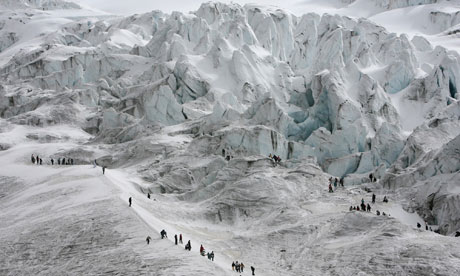Cayambe's receding ice mass highlights how global warming could leave some of the world's poorest people without water

Climate change has transformed vast swathes of Cayambe, once host to an annual ice harvesting competition, into bare rock. Photograph: Guillermo Granja/Reuters
The Cayambe volcano lies dead on the equator line in Ecuador and is the third-highest mountain in all the Americas at 17,159 ft (5,230m). It is really only climbed by serious "Andenistas" - as opposed to Alpinists - because of its crevasses and icecap, so the great Guardian/Oxfam climate expedition stopped at a modest 4,675m (14,250ft), which is nearly the height of Mont Blanc.
Okay, we went nearly all the way by Toyota pickup on a perilous track, but the wind was bitter and the snow lay deep on the glaciers.
Or what was left of them.
Where, just 25 years ago, there had been a three-kilometre long, 60-metre thick avalanche of ice, tumbling off the peak, we gazed down on bare, black rock. A whole valley once filled with ice was mostly empty. The snout of the glacier was 1,800 ft higher than it had been.
Our guide, the redoubtable Ecuadorean mountaineer Paul Williams, who has climbed Cayambe three times, remembered the glacier as a child. It use to stretch miles down the mountain. He was sad. "It was like losing a friend", he said.
Also with us was Bolivar Cereces, Ecuador's leading glaciologist. He is a conservative when it comes to glacier retreat, but he reckons that all Andean glaciers below 5,000 metres will be gone within 10-15 years. His forecast is based on a 1C predicted rise in global temperatures in the next 80 years. But with a 0.8C rise already recorded in the last 100 years, and temperatures in the Himalayas and other mountain regions rising much faster than expected, this may need to be revised.
What is certain is that most of the 20 glaciers on Cayambe are in full retreat. But Ecuador has no resources to monitor closely its seven icecaps, and all figures are estimates based on aerial photography, old photographs and local observation. The consenus is that nearly 40% of Cayambe's ice mass has been lost in a generation, with nearly 10% in the last decade.
For the next few years, glacier retreat may not be a great problem around Cayambe, because the extra melt water from the icecap makes up for the lack of rain that is being experienced. But this cannot last. Soon, the melting of the Andean cryosphere - or iceworld - will impact heavily on urban water supplies and therefore on some of the poorest people in the world, who depend on the rivers, which in turn depend on the melt water off mountains like Cayambe.
We made our way down the mountain, chastened by what we had seen and heard. But it was not all gloom. There was a good story of people adapting to climate change.
It seems that the small farmers, or campesinos, of Cayambe have, over generations, been steadily pushed up the mountain by the large landowners. This forced them on to what is known as the paramo, the high pastures on the mountain slopes that act as a giant sponge which stores and regulates water from the glaciers. Their cattle and the ploughing of land seriously degraded the land and led to water conflicts. In the dry season, the pasture land would dry up completely. Climate change, which has intensified and led to less rain in the last decade, only made things worse.
Then the community of several thousand indigenous people living on the mountain took matters into their own hands. In a social revolution, and without the absent state's permission, they drove the cattle of the rich farmers down the mountain, limited the numbers of their own allowed on the paramo, cleaned out many miles of old water channels, and banned the burning of the land. Now they reckon that they have increased water supplies to all farms by 10% - a clear case of conservation reversing the effects of climate change. Next, they plan to bring water all the way round the mountain from the east side, which gets more rain.
What is interesting is that these farmers linked climate change directly to their own poverty, and took responsibility for adapting to climate change without waiting for the state or the World Bank or NGOs. Inequality and colonialism caused climate change, they reasoned, so eliminate those and you will sort it. It is a microcosm of the political and social revolution going on all over Ecuador.
But if the glaciers really all go on Cayambe, the campesinos may have to think again.


your stats about the mountain are way off. The mountain is right around 19,000 feet depending on the glacier, and it is only the third highest in Ecuador, meaning it doesn't even make the top 50 in the Americas
ReplyDelete